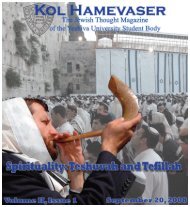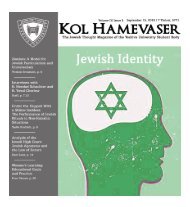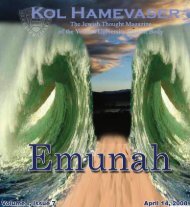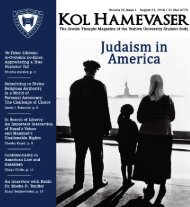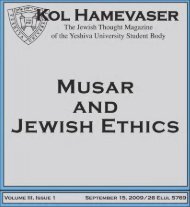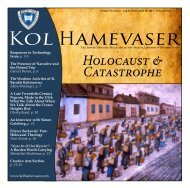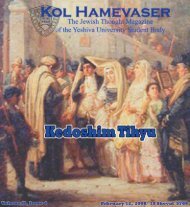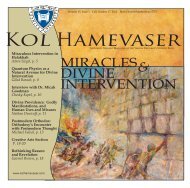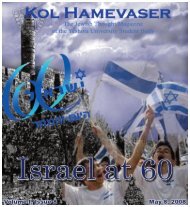You also want an ePaper? Increase the reach of your titles
YUMPU automatically turns print PDFs into web optimized ePapers that Google loves.
efore Milchemet Sheshet ha-Yamim (the Six<br />
Day War)! The Agudah today is not necessarily<br />
the same as the Agudah of 50 years ago. Everything<br />
is changing in the world. Halachah does<br />
not change but its application does.<br />
In terms of innovation, Halachah always<br />
has room for chiddush. The Yalkut Shim’oni<br />
comments on the pasuk in Shiras Devorah,<br />
“Yivchar E-lohim chadashim” (Hashem<br />
chooses new things), that Hashem cherishes<br />
chiddushei Torah (Torah novella). xix However,<br />
we do not allow shinnuyim (changes). You<br />
need to be a big talmid chacham to know what<br />
is considered a shinnui <strong>and</strong> what is considered<br />
a chiddush. Rav Moshe Feinstein is kullo chiddush<br />
(completely novel) – every teshuvah has<br />
a chiddush, <strong>and</strong> there is what to argue on in<br />
each case. But he is still working within the<br />
system of Halachah: he is using principles in<br />
the Gemara in order to change the application<br />
of Halachah, because he thinks that is what is<br />
necessary in our changing circumstances.<br />
What effect, if any, does scholarly research<br />
<strong>and</strong> manuscript use have on <strong>Halakhah</strong>?<br />
What effect, if any, does the discovery of new<br />
commentaries <strong>and</strong> hiddushim by Rishonim<br />
have on the halakhic process?<br />
Manuscript use is very important. We<br />
have to find out what the proper text is supposed<br />
to be. The Rema usually follows the<br />
opinions of Tosafos for Ashkenazim, but a lot<br />
of times there are gaps in Tosafos’ comments<br />
with words or even whole sentences missing<br />
that change the meaning entirely. In Avodah<br />
Zarah, for example, it is obvious that there are<br />
four whole lines missing in one Tosafos. Only<br />
if you look in the kisvei yad (manuscripts) <strong>and</strong><br />
parallel sources, like the Or Zarua, Tosafos<br />
Rabbeinu Elchanan, <strong>and</strong> Tosefei ha-Rosh, do<br />
you realize that they got lost in transmission.<br />
We live in a generation when we have the original<br />
versions of all of these texts <strong>and</strong> that helps<br />
a lot.<br />
The Seridei Esh has an essay in which he<br />
encourages everyone to use the Tosefei ha-<br />
Rosh <strong>and</strong> Tosafos Rabbeinu Elchanan because<br />
doing so helps a person underst<strong>and</strong> the comments<br />
of Tosafos. Today, that goes without saying,<br />
but if you lived 60 years ago, it was a big<br />
chiddush for him to have said that, because the<br />
attitude was that these sources were irrelevant.<br />
For example, Rav Moshe has a couple of<br />
teshuvos in which he says his own peshat in<br />
Tosafos <strong>and</strong> notes that even though the Tosefei<br />
ha-Rosh explains differently, we do not have<br />
follow it. xx What do you mean? Tosefei ha-<br />
Rosh gives you the peshat in Tosafos! It is all<br />
very strange. So at the time that the Seridei Esh<br />
was writing, he was revolutionary <strong>and</strong> his contemporaries<br />
did not go along with him. Today,<br />
though, it is a davar pashut that one should<br />
<strong>Halakhah</strong> <strong>and</strong> <strong>Minhag</strong><br />
look at the original set of the Ba’alei ha-<br />
Tosafos to make sure that one underst<strong>and</strong>s<br />
Tosafos properly.<br />
Similarly, it is very important to know<br />
what scholarly research has to say about the<br />
words of the Gemara. A lot of times scholars<br />
can help explain what the metsi’us (realia) was<br />
at the time of the Gemara. If you do not know<br />
the metsi’us, you will be misapplying the dinim<br />
or misunderst<strong>and</strong>ing the Halachah. This rule<br />
applies both lehachamir <strong>and</strong> lehakel – if we<br />
find out that the way we have been underst<strong>and</strong>ing<br />
the text all along is incorrect, it can change<br />
how we practice Halachah.<br />
The discovery of new commentaries <strong>and</strong><br />
Rishonim, however, is more complicated. The<br />
Mishnah Berurah used to always take these<br />
into consideration <strong>and</strong>, by doing so, reversed<br />
the pesak ha-mekubbal (accepted ruling) on almost<br />
every page of Shulchan Aruch (like the<br />
Vilna Gaon, he largely disregarded historic<br />
precedent). The reason he got away with it is<br />
that he was a holy tsaddik <strong>and</strong> a humble person.<br />
But the Chazon Ish was not happy about<br />
what the Mishnah Berurah had done – he<br />
thought Halachah had already been worked<br />
out. He felt that if you discover that there is a<br />
misprint in the Tosafos, that is one thing, but if<br />
you find new Rishonim besides Tosafos who<br />
say otherwise, that should not affect halachic<br />
practice – we have already decided to follow<br />
the Rishonim with which we have been familiar<br />
all these years.<br />
Is it valid for modern societal values <strong>and</strong><br />
movements, like freedom of speech, rationalism,<br />
egalitarianism, <strong>and</strong> nationalism, to affect<br />
halakhic decision-making <strong>and</strong> practice?<br />
Of course they affect pesak. A posek cannot<br />
give a pesak ha-tamuah al ha-rabbim (a<br />
ruling which surprises the masses). xxi You have<br />
to give a pesak that people can live with <strong>and</strong><br />
take all of these things into consideration when<br />
doing so. Everything going on in the genera-<br />
tion is part of the she’eilah. A she’eilah has to<br />
be considered from all of its perspectives <strong>and</strong><br />
one of the many perspectives is how the pesak<br />
will be accepted by the public. xxii So a posek<br />
has to be attuned to the needs <strong>and</strong> attitudes of<br />
his community.<br />
A posek also has to be aware of the personal<br />
needs of the sho’el. If the posek knows<br />
that the person asking will not be able to follow<br />
a machamir pesak <strong>and</strong> will get frustrated <strong>and</strong><br />
give up on his Jewish observance, he cannot<br />
say that what he is asking for is absolutely<br />
asur. He has to show him that there are different<br />
positions in Halachah on the issue <strong>and</strong> remind<br />
him that by following the more lenient<br />
opinion he is still acting within the halachic<br />
framework. We believe that eilu va-eilu divrei<br />
E-lohim Chayyim (these <strong>and</strong> those are the<br />
words of the Living God) is a halachic principle<br />
<strong>and</strong> that bi-she’as ha-dechak (in extremis)<br />
you can rely on the shittah ha-mekilah (lenient<br />
opinion). You have to give a pesak that people<br />
can live with <strong>and</strong> so the entire social <strong>and</strong> historical<br />
context of the she’eilah must be taken<br />
into consideration.<br />
How important is historical precedent in<br />
determining normative halakhic practice?<br />
When do we honor popular practice as halakhically<br />
justified?<br />
Most posekim usually follow a tradition<br />
in pesak. If you find that a community follows<br />
a certain practice against what you think to be<br />
normative, it is nevertheless valid, as long as<br />
you can establish that the practice was properly<br />
instituted by rabbanim in earlier generations.<br />
If, however, you find that the community’s<br />
posek said something that does not make sense,<br />
you may not follow it, even if it has become<br />
the basis for traditional practice there.<br />
Tosafos quotes the opinion of the Halachos<br />
Gedolos [Beha”g] that if you forget to<br />
count sefirah for one day, you should no longer<br />
continue to count with a berachah, but rejects<br />
it as completely incorrect. xxiii Nonetheless, because<br />
the Halachos Gedolos was from the tekufas<br />
ha-Ge’onim (Geonic period), we are<br />
choshesh (concerned) for his opinion <strong>and</strong> we<br />
continue counting on successive nights but<br />
“You have to give a pesak that people can live with<br />
<strong>and</strong> so the entire social <strong>and</strong> historical context of the<br />
she’eilah must be taken into consideration.”<br />
without a berachah. xxiv Similarly, the Halachos<br />
Gedolos rules that a woman may not be motsi<br />
(cause to fulfill) a man in keri’as ha-megillah<br />
(the reading of the megillah). So even though<br />
it seems that Tosafos disagrees with that position,<br />
xxv the Shulchan Aruch says that out of deference<br />
for the Beha”g, we do not allow a<br />
woman to be motsi a man. xxvi If a person is<br />
stuck <strong>and</strong> no one else is around to help him fulfill<br />
his chiyyuv (obligation) other than a<br />
woman, then bottom line we paskn that a<br />
woman can be motsi him. But if someone in<br />
our generation decides that a woman can read<br />
the megillah for men even when men are available<br />
to read, that is considered a chutspah<br />
gedolah (an extreme form of audacity) – unless<br />
it is someone, like Rav Moshe, who is very<br />
humble <strong>and</strong> is so convinced that the pesak ha-<br />
Volume III, Issue 7 www.kolhamevaser.com<br />
mekubbal is wrong <strong>and</strong> will be mevi li-yedei<br />
kilkul (lead to mistakes) if it continues to be<br />
followed. In a lot of instances, Rav Moshe felt<br />
that way <strong>and</strong> actually reversed normative practice<br />
quite a bit, as did the Mishnah Berurah.<br />
But to do that, you have to be a humble person<br />
steeped in learning <strong>and</strong> so convinced that the<br />
din is with you that you cannot allow Halachah<br />
to be followed in any other way.<br />
What qualifies a minhag as a minhag<br />
shetut (a foolish practice)?<br />
“You need to be a big talmid<br />
chacham to know what is<br />
considered a shinnui <strong>and</strong> what<br />
is considered a chiddush.”<br />
The first Mishnah in Bava Basra discusses<br />
the required width of different types of<br />
walls built between neighboring properties <strong>and</strong><br />
then concludes by saying “ha-kol ke-minhag<br />
ha-medinah” (everything follows local practice).<br />
Tosafos there quotes Rabbeinu Tam as<br />
saying that from the fact that the Mishnah had<br />
to specify widths of different types of walls<br />
<strong>and</strong> not just say “ha-kol ke-minhag ha-medinah,”<br />
we see that there are certain minhagim,<br />
minhagei shetus, that one is not supposed to<br />
observe. xxvii Similarly, in Rabbeinu Tam’s<br />
teshuvah, quoted by the Shiltei ha-Gibborim<br />
on the bottom of the Mordechai in Gittin, he<br />
says that the word “minhag” has the same letters<br />
as “Gehinnom,” showing that sometimes<br />
minhagim are ridiculous <strong>and</strong> lead you to<br />
Gehinnom. So a minhag shetus is any practice<br />
which has no kiyyum (fulfillment) in Halachah<br />
whatsoever.<br />
In order for a minhag to be considered<br />
valid, it must be a minhag vasikin (a minhag<br />
established or approved generations ago by<br />
talmidei chachamim). That is how the Magen<br />
Avraham explains the minhag to klap (make<br />
noise) when you hear Haman’s name during<br />
the keri’as ha-megillah. Even though it interferes<br />
with the megillah reading, he says, the<br />
minhag is apparently a minhag vasikin <strong>and</strong> so<br />
we should follow it. xxviii On the other h<strong>and</strong>, the<br />
Rambam writes that making a kinyan suddar<br />
(symbolic act of acquisition) when appointing<br />
a shaliach (messenger) for mechiras chamets<br />
(selling of the chamets) makes no sense because<br />
you do not need a kinyan at all. As a result,<br />
the Chazon Ish thought it was a minhag<br />
shetus <strong>and</strong> never made such a kinyan. In every<br />
generation, you have to reassess whether the<br />
minhagim are proper or improper.<br />
Is there a concept of minhag ha-makom<br />
(local practice) <strong>and</strong> lo titgodedu (do not create<br />
groups with different halakhic practices) in<br />
today’s Diaspora <strong>and</strong> Israeli Jewish communities?<br />
We still have a concept of minhag ha-<br />
23



